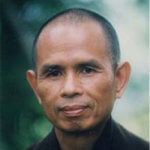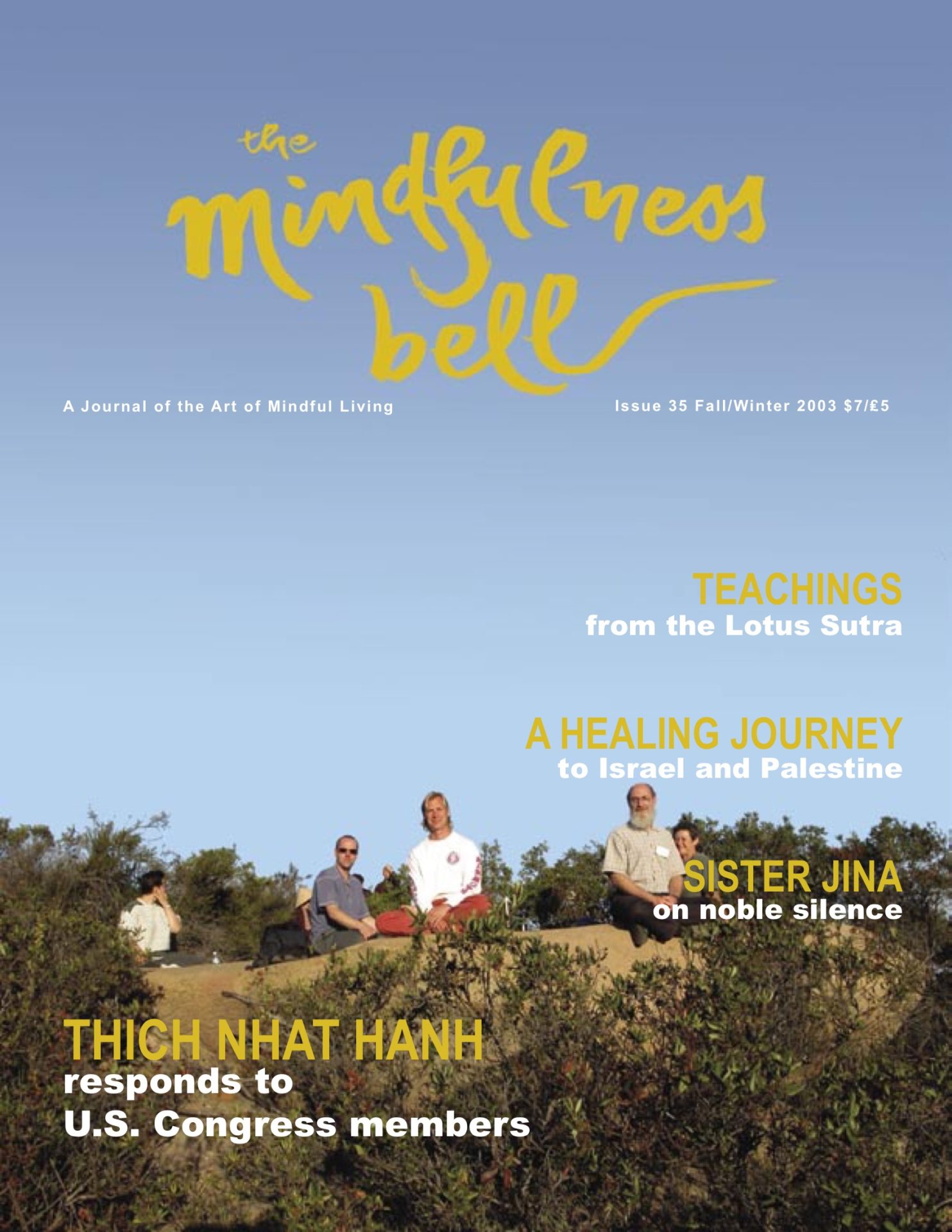Excerpt from Lotus Sutra book, by Thich Nhat Hanh, recently published by Parallax Press.
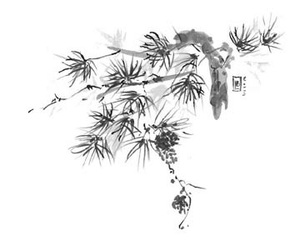
In Chapter Twenty of the Lotus Sutra we are introduced to a beautiful bodhisattva called Sadaparibhuta, “Never Disparaging.” The name of this bodhisattva can also be translated as “Never Despising.” This bodhisattva never disparages living beings, never underestimates them or doubts their capacity for Buddhahood. His message is, “I know you possess Buddha nature and you have the capacity to become a Buddha,” and this is exactly the message of the Lotus Sutra—you are already a Buddha in the ultimate dimension,
Excerpt from Lotus Sutra book, by Thich Nhat Hanh, recently published by Parallax Press.

In Chapter Twenty of the Lotus Sutra we are introduced to a beautiful bodhisattva called Sadaparibhuta, “Never Disparaging.” The name of this bodhisattva can also be translated as “Never Despising.” This bodhisattva never disparages living beings, never underestimates them or doubts their capacity for Buddhahood. His message is, “I know you possess Buddha nature and you have the capacity to become a Buddha,” and this is exactly the message of the Lotus Sutra—you are already a Buddha in the ultimate dimension, and you can become a Buddha in the historical dimension. Buddha nature, the nature of enlightenment and love, is already within you; all you need do is get in touch with it and manifest it. If you know this, if you are able to see your true nature in the ultimate dimension, then you will be able to realize Buddhahood in the historical dimension. Never Disparaging Bodhisattva is there to remind us of the essence of our true nature.
The action of this bodhisattva is to remove the feelings of worthlessness and low self-esteem in people. “How can I become a Buddha? How can I attain enlightenment? There is nothing in me except suffering, and I don’t know how to get free of my own suffering, much less help others. I am worthless.” Many people have these kinds of feelings, and they suffer more because of them. Never Despising Bodhisattva works to encourage and empower people who feel this way, to remind them that they too have Buddha nature, they too are a wonder of life, and they too can achieve what a Buddha achieves. This is a great message of hope and confidence. This is the practice of a bodhisattva in the action dimension.
Sadaparibhuta was actually Shakyamuni in one of his former lives, when the Buddha appeared as a bodhisattva in the world to perfect his practice of the Dharma. But this bodhisattva did not chant the sutras or practice in the usual way—he did not perform prostrations, or go on pilgrimages, or spend long hours in sitting meditation. Never Despising Bodhisattva had a specialty. Whenever he met someone he would address them very respectfully, saying, “You are someone of great value. You are a future Buddha. I see this potential in you.” There are passages in the Lotus Sutra that suggest that his message was not always well received. Because they have not yet gotten in touch with the ultimate dimension, many people could not believe what the bodhisattva was telling them about their inherent Buddha nature, and they thought he was mocking them. Often he was ridiculed, shouted at, and driven away. But even when people did not believe him and drove him away with insults and beatings, Never Despising did not become angry or abandon them. Standing at a distance he continued to shout out the truth:
“I do not hold you in contempt!
You are all treading the Path,
And shall all become Buddhas!” (1)
Never Despising is very sincere and has great equanimity. He never gives up on us. The meaning of his life, the fruition of his practice, is to bring this message of confidence and hope to everyone. This is the action of this great bodhisattva. We have to learn and practice this action if we want to follow the path of the bodhisattvas.
The sutra tells us that when Sadaparibhuta was near the end of his life he suddenly heard the voice of a Buddha called King of Imposing Sound (Bhishmagarjitasvararaja) teaching the Lotus Sutra. He could not see that Buddha but he clearly heard his voice delivering the sutra, and through the power of the teaching, Never Despising Bodhisattva suddenly found that his six sense organs were completely purified and he was no longer on the verge of death. Understanding deeply the message of the Lotus Sutra, he was able to touch his ultimate dimension and attain deathlessness.
We have already learned about the infinite life span of a Buddha in the ultimate dimension. In terms of the historical dimension, a Buddha may live 100 years or a little bit more or less; but in terms of the ultimate dimension a Buddha’s life span is limitless. Sadaparibhuta saw that his lifespan was infinite, just like the lifespan of a Buddha. He saw that every leaf, every pebble, every flower, every cloud has an infinite life span also, because he was able to touch the ultimate dimension in everything. This is one of the essential aspects of the Lotus message. When his sense organs had been purified, he could see very deeply and understand how the six sense organs (eyes, ears, nose, tongue, body, and mind) produce the six kinds of consciousness. When his senses had been purified he was capable of touching reality-as-it-is, the ultimate dimension. There was no more confusion, no more delusion, in his perception of things.
This passage in the sutra may sound as if it is about something magical or supernatural, but in fact it describes a kind of transformation that we too can experience. When the ground of our consciousness is prepared, when our sense consciousnesses and our mind consciousness have been purified through the practice of mindfulness and looking deeply into the ultimate dimension of reality, we can hear in the sound of the wind in the trees or the singing of the birds the truth of the Lotus Sutra. While lying on the grass or walking in meditation in the garden we can get in touch with the truth of the Dharma that is all around us all the time. We know that we are practicing the Lotus samadhi and our eyes, ears, nose, tongue, body, and mind are automatically transformed and purified.
Having realized the truth of the ultimate, Bodhisattva Sadaparibhuta continued to live for many millions of years, delivering his message of hope and confidence to countless beings. So we can see that the Lotus Sutra is a kind of medicine for long life. When we take this medicine we are able to live a very long time in order to be able to preserve and transmit the teachings of the Lotus Sutra to many others. We know that our true nature is unborn and undying, so we no longer fear death. Just like Never Despising Bodhisattva, we always dare to share the wonderful Dharma with all living beings. And all those who thought the bodhisattva was only making fun of them finally began to understand. Looking at Sadaparibhuta they were able to see the result of his practice, and so they began to have faith in it and to get in touch with their own ultimate nature.
This is the practice of this great bodhisattva—to regard others with a compassionate and wise gaze and hold up to them the insight of their ultimate nature, so that they can see themselves reflected there. So many people have the idea that they are not good at anything, that they are not able to be as successful as other people.
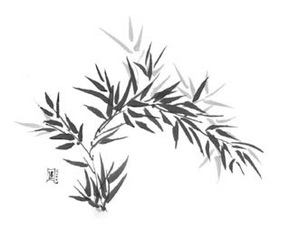
They cannot be happy; they envy the accomplishments and social standing of others while regarding themselves as failures if they do not have the same level of worldly success. We have to try to help those who feel this way. Following the practice of Sadaparibhuta we must come to them and say, “You should not have an inferiority complex. I see in you some very good seeds that can be developed and make you into a great being. If you look more deeply within and get in touch with those wholesome seeds in you, you will be able to overcome your feelings of unworthiness and manifest your true nature.”
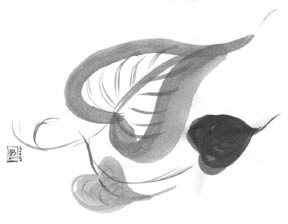
The Chinese Master Guishan writes,
We should not look down on ourselves.
We should not see ourselves as worthless and always
withdraw into the background. (2)
These words are designed to wake us up. In modern society, psychotherapists report that many people suffer from low self-esteem. They feel that they are worthless and have nothing to offer, and many of them sink into depression and can no longer function well, take care of themselves or their families. Therapists, healers, and caregivers, teachers, religious leaders, and those who are close to someone who suffers in this way all have the duty to help them see their true nature more clearly so that they can free themselves from the delusion that they are worthless. If we know friends or family members who see themselves as worthless, powerless, and incapable of doing anything good or meaningful, and this negative self-image has taken away all their happiness, we have to try to help our friend, our sister or brother, our parent, spouse, or partner remove this complex. This is the action of the bodhisattva Never Despising.
We also have to practice so as not to add to others’ feelings of worthlessness. In our daily life when we become impatient or irritated we might say things that are harsh, judgmental, and critical, especially to our children. When they are under a great deal of pressure, working very hard to support and care for their family, parents frequently make the mistake of uttering unkind, punitive, or blaming words in moments of stress or irritation. The ground of a child’s consciousness is still very young, still very fresh, so when we sow such negative seeds in our children we are destroying their capacity to be happy. So parents and teachers, siblings, and friends all have to be very careful and practice mindfulness in order to avoid sowing negative seeds in the minds of our children, family members, friends, and students.
And when our students or loved ones have feelings of low self-esteem we have to find a way to help them transform those feelings so that they can live with greater freedom, peace, and joy. We have to practice just like Never Despising Bodhisattva, who did not give up on people or lose patience with them but continued always to hold up to others a mirror of their true Buddha nature.
I always try to practice this kind of action. One day there were two young brothers who came to spend the day with me. I took them both to show them a new printing press I had just gotten. The younger boy was very interested in the machine, and while he was playing with it the motor burned out. As I was pressing one button to show the boys how it worked, the little boy pressed another at the same time, and it overstressed the machine’s engine. The elder brother said angrily, “Thay, you just wanted to show us the machine. Why did he have to do that? He wrecks whatever he touches.” These were very harsh words from such a young boy. Perhaps he had been influenced by hearing his parents or other family members use blaming language like this, so he was just repeating what he had heard without realizing the effect on his little brother.
In order to help mitigate the possible effects of his brother’s criticism on the younger boy, I showed the boys another machine, a paper cutter, and this time I instructed the younger one how to use it. His brother warned me, “Thay, don’t let him touch it, he’ll destroy this one too.” Seeing that this was a moment when I could help both boys, I said to the older brother, “Don’t worry, I have faith in him. He is intelligent. We shouldn’t think otherwise.” Then I said to the younger boy, “Here, this is how it works—just push this button. Once you have released this button then you press that button. Do this very carefully and the machine will work properly.” The younger brother followed my instructions and operated the machine without harming it.
He was very happy, and so was his older brother. And I was happy along with them.
Following the example of Sadaparibhuta Bodhisattva, I only needed three or four minutes to remove the complex of the younger brother and teach the older brother to learn to trust in the best of his younger brother and not just see him in terms of his mistakes. In truth, at that moment I was a bit concerned that the young boy would ruin the other machine. But if I had hesitated and not allowed him to try and follow my instructions, believing that he would destroy the machine, I could well have destroyed that little boy. Preserving the health and well-being of the mind of a child is much more important than preserving a machine, by a long way.
You only need to have faith in the action of Sadaparibhuta and very quickly you can help others overcome their negative self-image. Never Despising Bodhisattva shows everyone that they have the capacity for perfection within themselves, the capacity to become a Buddha, a fully enlightened one. The message of the Lotus Sutra is that everyone can and will become a Buddha. Sadaparibhuta is the ambassador of the Buddha and of the Lotus Sutra, and sometimes ambassadors are reviled or attacked. Never Despising Bodhisattva was also treated this way. He brought his message to everyone, but not everyone was happy to hear it because they could not believe in their own Buddha nature. So when they heard his message they felt they were being scorned or mocked, and, the sutra tells us, “throughout the passage of many years, he was constantly subjected to abuse…some in the multitude would beat him with sticks and staves, with tiles and stones.” (3) The mission of a Dharma teacher, of a bodhisattva, requires a great deal of love, equanimity, and inclusiveness.
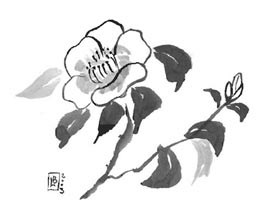
Sadaparibhuta Bodhisattva represents the action of inclusiveness, kshanti, one of the six paramitas, the bodhisattva practice of the perfections. Kshanti is also translated as “patience,” and we can see this great quality in Never Despising Bodhisattva and in one of the Shakyamuni’s disciples, Purna, who is praised by the Buddha in the eighth chapter of the Lotus Sutra. While the Lotus Sutra only mentions Purna in passing, he is the subject of another sutra, the Teaching Given to Maitrayaniputra. (4) In this sutra, after the Buddha had instructed Purna in the practice, he asked him, “Where will you go to share the Dharma and form a Sangha?” The monk said that he wanted to return to his native region, to the island of Sunaparanta in the Eastern Sea.
The Buddha said, “Bhikshu, that is a very difficult place. People there are very rough and violent. Do you think you have the capacity to go there to teach and help?”
“Yes, I think so, my Lord,” replied Purna. “What if they shout at you and insult you?”
Purna said, “If they only shout at me and insult me I think they are kind enough, because at least they aren’t throwing rocks or rotten vegetables at me. But even if they did, my Lord, I would still think that they are kind enough, because at least they are not using sticks to hit me.”
The Buddha continued, “And if they beat you with sticks?”
“I think they are still kind enough, since they are not using knives and swords to kill me.”
“And if they want to take your life? It’s possible that they would want to destroy you because you will be bringing a new kind of teaching, and they won’t understand at first and may be very suspicious and hostile,” the Buddha warned.
Purna replied, “Well, in that case I am ready to die. Because my dying will also be a kind of teaching and because I know that this body is not the only manifestation I have. I can manifest myself in many kinds of bodies. I don’t mind if they kill me, I don’t mind becoming the victim of their violence, because I believe that I can help them.”
The Buddha said, “Very good, my friend. I think that you are ready to go and help there.”
So Purna went to that land and he was able to gather a lay Sangha of 500 people practicing the mindfulness trainings, and also to establish a monastic community of around 500 practitioners. He was successful in his attempt to teach and transform the violent ways of the people in that country. Purna exemplifies the practice of kshanti, inclusiveness.
Never Despising Bodhisattva may have been a future or a former life of Purna. We are the same. If we know how to practice inclusiveness then we will also be the future life of this great bodhisattva. We know that Sadaparibhuta’s life span is infinite, and so we can be in touch with his action and aspiration at any moment. And when we follow the practice of inclusiveness of Never Despising Bodhisattva, he is reborn in us right in that very moment. We get in touch with the great faith and insight that everyone is a Buddha, the insight that is the very marrow of the Lotus Sutra. Then we can take up the career of the bodhisattva, carrying within our heart the deep confidence we have gained from this insight and sharing that confidence and insight with others.
Therapists and others in the healing professions, Dharma teachers, schoolteachers, parents, family members, colleagues, and friends can all learn to practice like Never Despising Bodhisattva. Following the path of faith, confidence, and inclusiveness we can help free many people from the suffering of negative self-image, help them recognize their true Buddha nature, and lead them into the ultimate dimension.
Illustrations by Lien Buu Olsson. She lives and practices in San Diego, California.
1 Hurvitz, Scripture of the Lotus Blossom of the Fine Dharma, p. 283.
2 Quote from “Awakening Words of Master Quy Son,” in Stepping Into Freedom [PUB INFO].
3 Hurvitz, Scripture of the Lotus Blossom of the Fine Dharma, pp. 280–1.
4 Teaching Given to Maitrayaniputra , REF Pali/Skt and/or Chinese texts, translations
